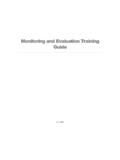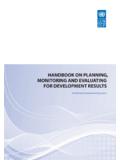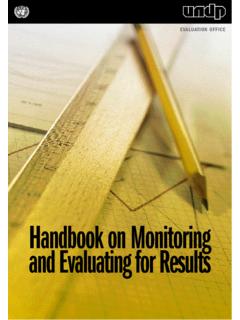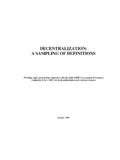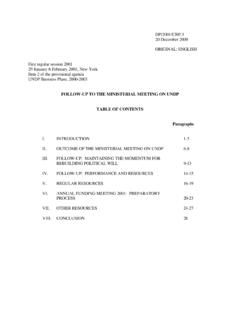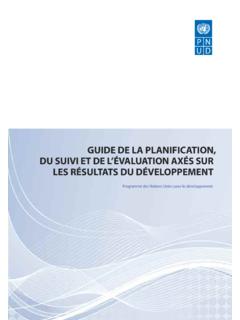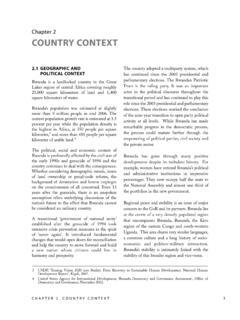Transcription of Results Based Management - UNDP
1 Results Based Management Concepts and Methodology Page 2 IINNTTRROODDUUCCTTIIOONN The present note provides guidance to operating units1 on Results - Based Management (RBM) in UNDP. The note offers an explanation of the conceptual and methodological building blocks as well as the instruments that represent UNDP s application of the RBM philosophy. It is intended to help establish organisation-wide standards with regard to key aspects of Results methodology and terminology. Managing for Results is not completely new to UNDP but what makes the current approach different is the determination to make RBM the driving force behind the organisation s institutional culture and practice and to develop and apply a corporate methodology for this purpose.
2 WWHHAATT IISS RRBBMM?? The objective of RBM is to provide a coherent framework for strategic planning and Management Based on learning and accountability in a decentralised environment. 2 Introducing a Results - Based approach aims to improve Management effectiveness and accountability by defining realistic expected Results , monitoring progress toward the achievement of expected Results , integrating lessons learned into Management decisions and reporting on performance .3 1 The term operating units is used to cover all country offices, funds and headquarters units that have individual budgets and reporting responsibilities.
3 2 Note on RBM, Operations Evaluation Department, World Bank, 1997. 3 Results - Based Management in Canadian International Development Agency , CIDA, January 1999. RBM in UNDP is Based on four main pillars: the definition of strategic goals which provide a focus for action; the specification of expected Results which contribute to these goals and align programmes, processes and resources behind them; on-going monitoring and assessment of performance, integrating lessons learnt into future planning; improved accountability, Based on continuous feedback to improve performance. MMAANNAAGGIINNGG FFOORR RREESSUULLTTSS TTyyppeess ooff DDeevveellooppmmeenntt RReessuullttss UNDP s approach to Results - Based Management is centred on two types of development result: outputs and outcomes.
4 In RBM, inputs and the activities which transform them into outputs reflect the process of implementing projects/programmes4 rather than desirable end Results in themselves. From a Results perspective, the implementation process is significant only in terms of what it leads to or what follows from the process of planning, managing and implementing. Outputs are the specific products and services which emerge from processing inputs through programme or non-programme activities. Outputs, therefore, relate to the completion (rather than the conduct) of activities and are the 4 The term programme is used in this document to denote any project, programme or other programmatic intervention irrespective of its being formalized as a project document or a programme support document (PSD).
5 UNDP Results Framework Technical Note: 2000 Page 3 type of result over which managers have a high degree of influence. Outcomes are actual or intended changes in development conditions that UNDP interventions are seeking to support. They describe a change in development conditions between the completion of outputs and the achievement of impact (see Figure 1). To assist in distinguishing between outputs and outcomes, three tests may be applied (see Box 1). Outputs and outcomes of varying degrees of ambition can be chosen. Guidance on choosing outputs and outcomes with a level of ambition to fit the country context and UNDP s resources is given below.
6 An individual UNDP output or even a cluster of outputs will not guarantee the achievement of a related outcome, since the contribution of wider group of partners is usually essential. Ideally, outcomes should be agreed to by the partners involved as necessary to have a positive influence on a development issue within a reasonable period of time. Seeking to influence development outcomes is, therefore, by its very nature dependent on partnerships. Since several actors are involved, outcomes cannot necessarily be attributed to any one party (such as UNDP). Box 1: Tests to Distinguish between Outcomes and Outputs Outcomes Outputs (1) Does it represent a development change?
7 Eg changes in policies/regulations/laws, access to assets or services by the poor, environmental conservation or institutional capacity. (1) Does it make a significant contribution to the achievement of the related outcome? Although UNDP cannot achieve outcomes on its own, we do want to make an important contribution to their achievement. (2) Does it require the help of at least one (or perhaps more) partners? Outcomes are developmental changes which by their very nature cannot be achieved by UNDP on its own. (2) Can it be delivered by UNDP? Again, although you could argue that even outputs are achieved with the help of at least one partner, UNDP should feel confident that it has a high degree of control over the achievement or non-achievement of the output.
8 (3) Can it be achieved by the end of the SRF/CCF period? Results included in the SRF must be achievable within the SRF period, or the CCF period (if this is later). (3) Can it be achieved by end of the SRF/CCF period? Results incorporated into the SRF, including outputs, must be achievable within the SRF/CCF period. Experts; equipment; funds People trained; studies completed Conditions improved:health/ longevity Jobs created; incomes increased InputsOutputsOutcomesImpactFigure 1: W hat are Results : Outputs and Outcomes>UNDP Results Framework Technical Note: 2000 Page 4 Page 4 Box 2: Example Outputs and Outcomes The following example outputs reflect an increasing level ofambition and an increasing reliance on the securing thetrust and cooperation of partners.
9 It is importance to defineoutputs which are likely to make a significant contribution tooutcomes, but which take account of the country contextand are therefore realistic within the timeframe of theCCF/SRF: Outputs: Completion of a study of environment-poverty linkages; Police forces and judiciary trained in understanding ofgender violence; National, participatory forum held to discuss draftnational anti-poverty strategy; National human development report produced; Revised electoral dispute resolution mechanismestablished. The examples below illustrate outcomes with an increasinglevel of ambition. As the level of ambition increases, so theimportance of partnership grows, and the directness orcredibility of linkages to key UNDP outputs diminishes.
10 Outcomes: Improved national capacity to monitor human andincome poverty and inequality; Legislation passed which promotes local adoption ofsustainable energy technologies. Increased access of the poor to finance (formal,informal, micro). Reduction in the level of domestic violence againstwomen. Increased regional and sub-regional trade. DDeecciiddiinngg tthhee AAmmbbiittiioonn ooff OOuuttppuuttss aanndd OOuuttccoommeess Figure 2 illustrates how outputs and outcomes of varying degrees of ambition may be chosen. The approach in UNDP is to select only those outputs that clearly have a significant role to play in contributing towards major outcomes.
